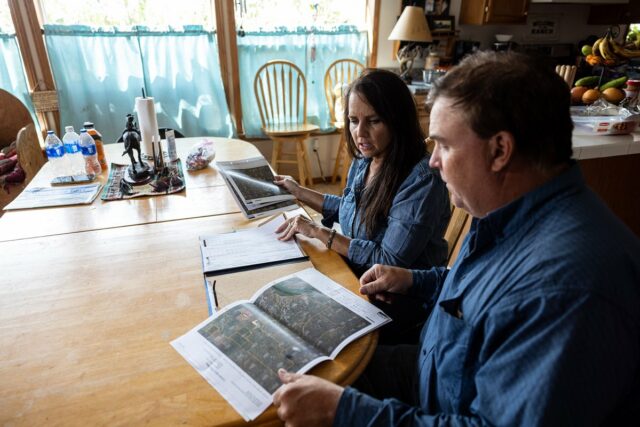The Brewers run cattle and grow some alfalfa across 12,000 acres of grassland that’s a combination of owned land, leased tribal land, and federal trust land. This complicated arrangement isn’t unusual for Indigenous producers, who experience unique hurdles such as financial lending discrimination, limited land ownership opportunities, additional governance requirements, and disproportionately high poverty rates as a result of colonialism.
“Some Native families never develop that generational wealth, whereas our non-Native neighbor, whose family has owned their land since the late 1800s, has been able to grow their business.”
Despite these systemic obstacles, the Brewers plant cover crops between alfalfa rotations and use fewer chemicals on their crops than most conventional operations. They’d like to use more regenerative ranching practices, including adaptive, multi-paddock grazing, on more land and help prove that those practices are worth investing in.
For those reasons, the ranch is one of 14 operations participating in a three-year study from the Environmental Defense Fund (EDF) and the Intertribal Agriculture Council (IAC) that is examining the benefits and barriers of regenerative agriculture among Indigenous ranchers and farmers in North Dakota, South Dakota, Nebraska, and Montana.
“The volatility of leasing land and how it affects your borrowing power with banks has always been a struggle for Native producers,” says Brewer, who also serves as the IAC’s Great Plains technical assistance specialist. “Some Native families never develop that generational wealth, whereas our non-Native neighbor, whose family has owned their land since the late 1800s, has been able to grow their business. Those are the hard realities we have to face.”
She points to a recent example when a desirable plot of land came up for sale. Compared to a local non-Native rancher who could leverage her owned land and secure a bank loan quickly to purchase that real estate, Brewer needed to put up her livestock, machinery, and other material assets as collateral since her family doesn’t own all their land—and it took weeks to assess.
“I don’t hold anything against her, but I didn’t realize until then how differently we approach things,” Brewer says. “At that time, I chose to pull out some of our land that was in trust with the U.S. government and put it in deed status so that the next time I walk into the bank, I have more power. Some people have questioned my moves, but these are choices I have had to make for my family so we can take control of our own destiny.”
This is an all too common experience among Indigenous entrepreneurs, says Skya Ducheneaux, also a member of the Cheyenne River Sioux Tribe and the founder of the Native-focused community development financial institution (CDFI) Akiptan. “Many Native producers aren’t able to list their land on their balance sheet, so they can’t leverage that value,” she explains. “When you don’t have as much equity to leverage, lending institutions deem you risky, and because of that, you get shorter repayment terms and higher interest rates. You end up stuck in this cycle of just surviving.”
Regenerative practices—most of which are already in Indigenous farmers’ and ranchers’ wheelhouses because they align more closely with, and are often based upon, their traditional practices—are much harder to employ because they’re more expensive and labor-intensive.
Brewer chose to participate in the EDF/IAC study because it will yield quantitative data about both those costs—including financial investments and loan terms—as well as the benefits of investing in regenerative practices, such as profitability, soil health improvement, forage quality, and livestock growth. To gather that information, the pilot cohort is receiving technical assistance from the IAC team and participating in the Minnesota Farm Business Management Program. Offered through the Minnesota State Colleges and Universities system, it provides one-on-one financial education such as record keeping and performance analysis.
Fanny Brewer, IAC technical assistance specialist for the Great Plains region, discusses the regenerative agriculture projects with Jess Brewer. (Photo courtesy of Intertribal Agriculture Council, www.indianag.org)
All of the producers in the study raise livestock, and some also grows crops. Many are in the process of transitioning from more extractive conventional methods to regenerative practices, with data being collected from 2022 through 2024. Although full results will not be available until the project’s completion, researchers are developing intermediate case studies, including one that should be released before the end of the year.
The researchers hope the study encourages producers to adopt climate-smart practices, such as using adaptive grazing, planting cover crops, and reducing tillage. The larger goal, however, is to urge financial institutions to reframe their understanding of Indigenous ranchers and farmers, who are often considered high-risk given their limited equity.
The shift to regenerative practices can take three to five years and reduce profitability by up to $40 per acre during the transition, according to recent research by the World Business Council for Sustainable Development’s One Planet Business for Biodiversity coalition. But farmers and ranchers can expect a 15 to 25 percent return on investment and profit growth by up to 120 percent in the long run, according to the study, which calls for public and private assistance to alleviate these burdens placed on the individual business owners.





